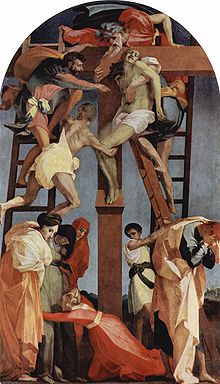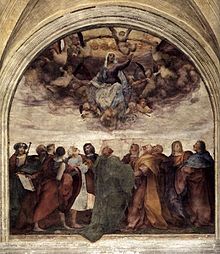Rosso Fiorentino

Rosso Fiorentino (born March 8, 1495 in Florence , † November 14, 1540 in Paris ; real name Giovan Battista di Jacopo ) was an Italian mannerist painter .
life and work
Florence and Rome
There is little reliable data about Rosso's beginnings as a painter. One of the most important contemporary sources about him is the book Le Vite de 'più eccellenti architetti, pittori et scultori italiani by Giorgio Vasari, first published in 1550 . He does not assign him to any of the possible teachers, since his works contradict those of potential teachers. Probably he was trained together with Pontormo by Andrea del Sarto . On February 26, 1516, Rosso Fiorentino became a member of the Florence painters' guild.
The stage name Rosso Fiorentino refers to the artist's red hair.
One of his first secured works dates from 1517, a resurrection that is still strongly based on del Sarto and Pontormo and does not yet reveal Rosso's handwriting. The designs for an altarpiece Madonna with Child and Saints for the Hospital S. Maria Nuova in Florence alienated his clients, to whom the saints appeared more like devils. The saints surrounding the Madonna and Child in the final version also do not correspond to a traditional norm. John the Baptist, in the usual hairy robe belted with a blue silk bow, is dressed in light, white silk and pink robes. He is juxtaposed with an emaciated, spiritualized Hieronymus , whose over-long limbs and delicate hands are gracefully staged. In 1521 Rosso stayed in Volterra .

His descent from the cross for the cathedral there is highly theatrical , both as regards the upper group, excitedly circling around the body of Christ, and the group of six people gathered around the cross, in which he plays through all the degrees of grief and pain. Rosso's closeness to Pontormo is evident in the bright colors of these pictures.
The following year he went to Arezzo and in 1523 to Rome, where he worked until 1527. Rosso was impressed by Michelangelo, whose works he studied and who have left their mark on his paintings. The painting of Moses and the Daughters of Jethro from 1523 is inconceivable without Michelangelo's nudes. The same applies to the picture painted for Cardinal Lorenzo Tornabuoni The dead Christ with the torch-bearing angels , which also shows the results of Rosso's study of antiquity. With the Sacco di Roma in 1527, Rosso lost his workshop, assets and clients. Like many of his colleagues, he left the city to look for new patrons in northern Italy, for example in Città di Castello , Perugia , Borgo Sansepolcro , Arezzo and Venice.
Fontainebleau
In 1530, at the invitation of the king, he traveled to the court of Francis I in Fontainebleau , which he reached in 1531. He worked there for the next ten years until his death. He had the status of court painter and was awarded the office of canon at the Sainte Chapelle in 1532. Rosso never left France.
The king had the medieval castle rebuilt and expanded. When Rosso arrived, the construction was complete and Rosso was commissioned to decorate the interior. His main work is the gallery , the first of its kind in a French castle. The elongated room is furnished with pictures and white stucco sculptures that follow a complex and difficult to interpret program. Typical of Mannerism in Fontainebleau is the combination of painting, sculpture, color-intensive ornaments, wood carvings and scrollwork, historical paintings and mythological images.
In 1532 Francis I called the painter Primaticcio , who had worked with Giulio Romano in Mantua, to Fontainebleau, who worked closely with Rosso and continued work on the interior after his death.
Rosso and Primaticcio are considered the founders of the First School of Fontainebleau and made it the center of Mannerism north of the Alps.
Graphics
Rosso used to prepare his paintings in drawings, of which only a few have survived. His works were disseminated through engravings by Cherubino Alberti , Gian Giacomo Caraglio , René Boyvin and others. The term Fontainebleau School was first used in 1818 to identify and summarize the graphic production from Fontainebleau, the sheets of which are often unsigned.
Influences
The literature names works by Andrea del Sarto , Fra Bartolommeo , Michelangelo Buonarroti and Albrecht Dürer as influential for the art of Rosso Fiorentino .
Works
- Assumption of the Virgin , 1517, Florence, Santissima Annunziata
- Madonna with Four Saints , 1518, Florence, Galleria degli Uffizi
- Descent from the Cross , 1521, Volterra, Pinacoteca Communale
- Madonna with two saints , 1521, Villamagna, Chiesa Parrocchiale
- Madonna with Ten Saints , 1522, Florence, Palazzo Pitti
- Moses defending the daughters of Jethro , Florence, 1523, Galleria degli Uffizi
- Engagement of the Virgin , 1523, Florence, S. Lorenzo
- The Fall of Man , 1524, Rome, S. Maria della Pace
- Creation of Eve , 1524, Rome, S. Maria della Pace
- Christ with Angels , 1524–1527, Boston, Museum of Fine Arts
- Descent from the Cross , 1528, Sansepolcro, S. Lorenzo
- Transfiguration of Christ , 1528, Sansepolcro, S. Lorenzo
- Cathedral of Città di Castello
- Leda with the Swan , 1530, London, Royal Academy
- Pietà , 1537–1540, Paris, Musée National du Louvre
- The Nymph of Fontainebleau , engraving by Pierre Milan and René Boyvin after Rosso Fiorentino, around 1545
- Angel playing music , 1521–1524, Florence, Galleria degli Uffizi metmuseum.org
literature
- Kurt Kusenberg : Rosso, Giovanni Battista di Jacopo di Guasparre, called Il Rosso (Fiorentino) . In: Hans Vollmer (Hrsg.): General lexicon of fine artists from antiquity to the present . Founded by Ulrich Thieme and Felix Becker . tape 29 : Rosa – Scheffauer . EA Seemann, Leipzig 1935, p. 61-63 .
- Kurt Kusenberg: Le Rosso. Paris 1931 (with plates; German first version without T .: Heitz, Strasbourg 1931, 80 ills. - Diss. Phil. Albert-Ludwigs-Universität 1928)
- Paula Barrocchi: Il Rosso Fiorentino. Rome 1950.
- Erwin Panofsky : The Iconography of the Galérie François Ier at Fontainebleau. In: Gazette des Beaux-Arts . Vol. 100, 1958, LI-LII.
- John Shearman : The Dead Christ by Rosso Fiorentino. In: Boston Museum Bulletin, LXIV. 1966.
- La Galerie de Francois., Revue de l'Art. 1972.
- École de Fontainebleau. Catalog. Paris 1972/1973.
- G. Kauffmann, G. Passavant: The "School of Fontainebleau". In: Art Chronicle. Vol. 26, No. 4, 1973.
- Rosso Fiorentino. In: Lexicon of Art. Volume IV, Leipzig 1977.
- V. Plagemann: Rosso Fiorentino. In: Kindler's Painting Lexicon. Volume 10, 1985.
- David Franklin: Rosso in Italy: the Italian career of Rosso Fiorentino. Yale Univ. Press, New Haven [et al. a.] 1994.
- Giorgo Vasari. The life of Rosso Fiorentino. Edition Giorgio Vasari, Volume 6. In the new translation by Victoria Lorini. Edited by Alessandro Nova . Arranged by Sabine Feser. Verlag Klaus Wagenbach, Berlin 2004, ISBN 978-3-8031-5025-7 .
- Ulrich Wilmes: Rosso Fiorentino and Mannerism: a contribution to the development of panel painting in the 16th century. Verlag Die Blaue Eule, Essen 1985, ISBN 3-924368-78-3 .
Web links
- Works by Rosso Fiorentino at Zeno.org .
Individual evidence
- ↑ 1495 according to the Gregorian calendar, Kusenberg states 1494, the cause is the different calendar for Florence
- ^ Nikolaus Pevsner: European architecture . 6th edition. Prestel, Munich, p. 220 .
| personal data | |
|---|---|
| SURNAME | Rosso Fiorentino |
| ALTERNATIVE NAMES | Giambattista di Jacopo; il Rosso; il Rosso Fiorentino; Maître Roux; Rosso, Giovanni Battista di Jacopo; Giovanni Battista di Jacopo; Giovanni Battista di Jacopo di Guasparre; Giovan Battista di Jacopo |
| BRIEF DESCRIPTION | Italian mannerism painter |
| DATE OF BIRTH | March 8, 1495 |
| PLACE OF BIRTH | Florence |
| DATE OF DEATH | November 14, 1540 |
| Place of death | Paris |
